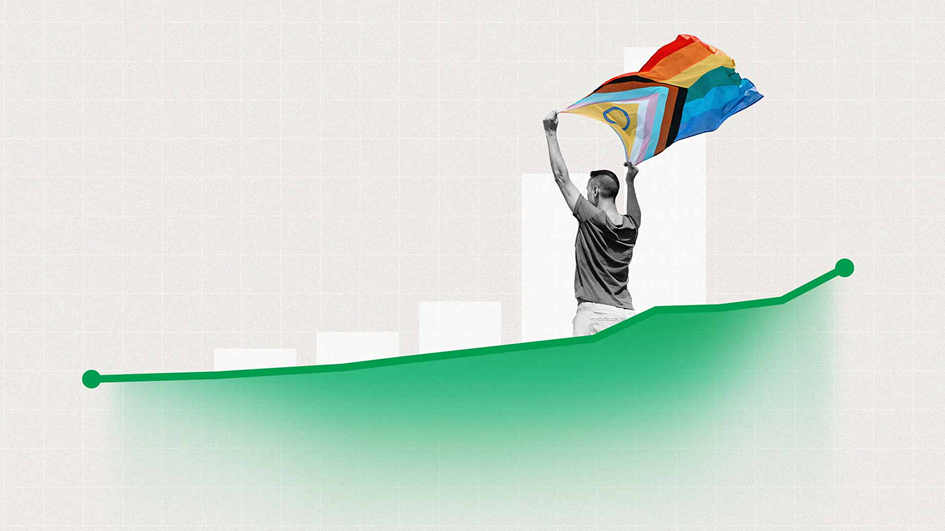
A new Gallup poll published in February 2025 shows that 9.3% of American adults now identify as part of the LGBTQ+ community. This is the highest percentage Gallup has measured since it began recording sexual orientation and gender identity in the population in 2012. The figures mark a remarkable development in American society, where coming out as lesbian, gay, bisexual, transgender, or queer has become more common and—for some—less associated with social stigma. In 2020, the proportion was 5.6%, meaning that almost twice as many Americans today openly identify as LGBTQ+ compared to just five years ago.
The figures clearly show that we are in the midst of a cultural change, where issues of identity and sexual orientation are being discussed more openly – both in the media, in families and in public debate. At the same time, this raises new questions about how institutions such as the school system, the healthcare system, and the labor market should adapt to a more diverse population.
Among the demographic data, Generation Z (born 1997–2006) stands out significantly. Here, as many as 23.1% identify as LGBTQ+ – almost one in four. This is a significantly higher proportion than among Millennials (born 1981–1996), where the figure is 14%. For Generation X (born 1965–1980), the figure is 5%, while the proportion among Baby Boomers (2.3%) and the oldest group, the so-called Silent Generation (1.8%), is even lower.
The difference points to a clear trend: the younger you are, the more likely you are to identify outside the heterosexual or cisgender norm. This may be due to both changing attitudes in society and greater freedom to experiment with or express one's identity. For many young people, gender and sexuality are not fixed categories, but something that can be fluid and personal.
Psychotherapist and sexologist Maj Tverskov, who works with gender and identity issues on a daily basis, explains the development as follows:
"In recent years, we have seen a break with binary notions of gender and sexuality. Young people have access to a much broader language to describe who they are, and this means that more people dare to be open about their identity—not only to others, but also to themselves."
When you delve into how the 9.3% identify themselves within the LGBTQ+ spectrum, a clear picture emerges: bisexuality is the most common identity. A full 5.2% of the adults surveyed identify as bisexual, which corresponds to 56% of all those who state that they belong to the LGBTQ+ group.
By comparison, 2.0% identify as gay (men who are attracted to men), 1.4% as lesbian (women who are attracted to women), and 1.3% as transgender. In addition, 0.6% indicate another identity, such as pansexual, asexual, or queer.
The fact that bisexuality features so prominently in the statistics is an important point – not least because bisexuals are often overlooked in both heteronormative and homosexual contexts. At the same time, the figures show that sexual orientation is not necessarily an either/or proposition, but often involves nuances and complexities that American society is increasingly recognizing.
The survey also shows that women are more likely than men to identify as LGBTQ+. 10% of women answer yes to the question, compared to 6% of men. In particular, the proportion of women who identify as bisexual is higher, which, according to researchers, may be related to both social acceptance and cultural perceptions of women's sexuality.
There are also significant differences depending on political stance. Among people who identify as liberal, the proportion is as high as 21%, while only 3% of conservatives identify as LGBTQ+. The distribution is also clear in terms of party politics: 14% of Democrats say they are LGBTQ+, compared to just 3% of Republicans. This shows how identity is not just a personal matter, but is also influenced by social and political structures.
Geography also plays a role. In urban areas, 11% identify as LGBTQ+, in the suburbs 10%, while in rural areas only 7% do. This confirms a well-known trend in the US, where large cities and urban environments serve as safe havens for gender and sexual diversity. In rural areas, social norms and conservative values can still put pressure on those who break with the norm.
At a time when LGBTQ+ rights are under pressure in many parts of the US—with new laws on sex education, bans on transgender people in sports, and restrictions on access to gender-affirming care—the Gallup figures also bear witness to a culture war. While some are trying to roll back rights, a new generation is stepping forward and demanding to be seen and heard on their own terms.
Gallup's survey is based on telephone interviews with over 14,000 American adults during 2024. This makes it one of the most comprehensive and reliable studies of LGBTQ+ identification in the US. According to the institute itself, it will follow developments year by year to document how the population's self-understanding and expression of identity change over time.
Everything indicates that the proportion will increase further as Generation Z and subsequent generations grow older. American society is moving—slowly but surely—toward greater visibility and acceptance. But this is not happening without resistance, and therefore the figures can also be read as a reminder: of the need to listen to new voices, and that identity politics is not just about words and labels—but about people and their lives.
In light of this, Donald Trump's opposition to DEI (Diversity, Equity and Inclusion) initiatives appears particularly problematic. His policies, which actively seek to limit the focus on diversity and equality in public institutions and the business community, risk marginalizing the very groups that this study shows are growing and in need of visibility and recognition. The numbers speak for themselves: it is not the minority that is growing too large – it is the systems that must keep up with reality.